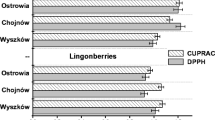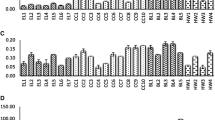Abstract
Worldwide, the market and consumption of berries has shown an increase as a result of the versatility that the fruit presents when marketed in different presentations. Their nutritional properties and the content of phenolic compounds (anthocyanins), which provide benefits such as antioxidants, antimicrobials, anti-inflammatory, and chemopreventive properties, are also favorable. The aim of this study is to determine the phenolic profile and antioxidant capacity in blackberry fruits grown in Boyacá, Colombia. The study describes the content of phenolic compounds (carried out using the Folin-Ciocalteu method), the antioxidant capacity (2,2-diphenyl-1-picrylhydrazyl [DPPH] and 2,2′-azino-bis-3-ethylbenzothiazoline-6-sulphonic acid [ABTS]), the content of anthocyanins (differential pH method), color (CIELAB system), and the profiles of phenolic compounds (ultra-high performance liquid chromatography [UHPLC]) in fruits of three species of fully mature blackberries (Rubus sp.). In the species of the genus Rubus studied, anthocyanins (within 257–264 mg cyanidin-3-O-glycoside equivalent 100 g–1) and certain flavonoids contribute significantly to color, antioxidant capacity, and a number of bioactive attributes. Nine phenolic compounds were found in representative concentrations for each species (catechin, epicatechin, pinocembrin, quercetin, and anthocyanins of different types). Additionally, this study is the first to identify the phenolic profile in fruits of R. alutaceus and identify the compound kaempferol-3-glucoside (5.8 mg kg) as a possible chemotaxonomic marker of the species.



Similar content being viewed by others
References
Amidžić Klarić D, Klarić I, Mornar A, Velić N, Velić D (2020) Assessment of bioactive phenolic compounds and antioxidant activity of blackberry wines. Foods 9:1623. https://doi.org/10.3390/foods9111623
Andersen ØM, Jordheim M (2010) Chemistry of flavonoid-based colors in plants. In: Comprehensive natural products II:Chemestry and biology. Elsevier, Oxford, pp 547–614 https://doi.org/10.1016/B978-008045382-8.00086-1
Arango-Varela S, Torres-Camargo D, Reyes-Dieck C, Zapata-Londo MB, Maldonado-Celis ME (2021) Aqueous extract of andean berry induces apoptosis in human colon cancer cells without mitochondrial damage. J Berry Res 11:377–393. https://doi.org/10.3233/JBR-200684
Ballestero S, Blanco A, Gómez M, Guzmán AP, Sánchez V, Villalobos Y et al (2004) Aspectos biológicos y taxonómicos de Rubus ellipticus “Mora amarilla silvestre”, un recurso fitogenético con potencial en Costa Rica Tecnol. Marcha 17(1):18–21
Brand W, Cuvelier W, Berset M (1995) Use of free radical method to evaluate antioxidant activity. Lebensm Wiss Technol 22:25–30
Chalker-Scott L (1999) Environmental significance of anthocyanins in plant stress responses. Photochem Photobiol 70:1–9. https://doi.org/10.1111/j.1751-1097.1999.tb01944.x
Coronado MA, García M, Hernández S, Guadalupe V, Córdova A, Vásquez R (2014) La zarzamora, un mercado potencial para los productores agropecuarios de la sierra de sonora. Rev Mex Agroneg 34:784–794
Croge CP, Cuquel FL, Pintro P, Biasi LA, De Bona C (2019) Antioxidant capacity and polyphenolic compounds of blackberries produced in different climates. HortScience 54(12):2209. https://doi.org/10.21273/HORTSCI14377-19
Edgley M, Close DC, Measham PF (2020) Red drupelet reversion in blackberries: A complex of genetic and environmental factors. Sci Hortic 272:109555. https://doi.org/10.1016/j.scienta.2020.109555
Eppel A, Keren N, Salomon E, Volis S, Rachmilevitch S (2013) The response of Hordeum spontaneum desert ecotype to drought and excessive light intensity is characterized by induction of O2 dependent photochemical activity and anthocyanin accumulation. Plant Sci 201–202(1):74–80. https://doi.org/10.1016/j.plantsci.2012.12.002
Eyduran SP, Akin M, Ercisli S, Eyduran E, Maghradze D (2015) Sugars, organic acids, and phenolic compounds of ancient grape cultivars (Vitis vinifera L.) from Igdir province of Eastern Turkey. Biol Res 48(1):1–8. https://doi.org/10.1186/0717-6287-48-2
Fuentes JL (2019) Las plantas como fuente de compuestos fotoprotectores frente al daño en el ADN producido por la radiación ultravioleta. Rev Acad Colomb Cienc Ex Fis Nat 43(168):550–562. https://doi.org/10.18257/raccefyn.841
Garzón GA, Soto C, López‑R M, Kenneth MR, Browmiller CR, Howard L (2020) Phenolic profile, in vitro antimicrobial activity and antioxidant capacity of Vaccinium meridionale Swartz pomace. Heliyon 6(5):e3845. https://doi.org/10.1016/j.heliyon.2020.e03845
Gecer MK, Orman E, Gundogdu M, Ercisli S, Karunakaran R (2022) Identification of metabolites changes and quality in strawberry fruit: Effect of cultivation in high tunnel and open field. Plants 11(10):1368. https://doi.org/10.3390/plants11101368
Giusti M, Wrolstad R (2001) Determination of total phenolics. In: Wrolstad RE (ed) Handbook of food analytical chemistry. John Wiley & Sons, New Jersey, pp 19–31
Hummer KE (2010) Rubus pharmacology: antiquity to the present. HortScience 45(11):1587–1591. https://doi.org/10.21273/HORTSCI.45.11.1587
IDEAM-Instituto de hidrología, meteorología y estudios ambientales (2010) Subdirección de Meteorología. http://atlas.ideam.gov.co/basefiles/temperatura-boyaca.pdf. Accessed 26 June 2020
Kumar S, Pandey AK (2013) Chemistry and biological activities of flavonoids: an overview. Sci World J. https://doi.org/10.1155/2013/162750
Kuskoski E, Asuero A, Troncoso A, Filho J, Fett R (2005) Aplicación de diversos métodos químicos para determinar actividad antioxidante en pulpa de frutos. Ciênc Tecnol Aliment 25:726–732
Liu Y, Tikunov Y, Schouten RE, Marcelis LFM, Visser RGF, Bovy A (2018) Anthocyanin biosynthesis and degradation mechanisms in Solanaceous vegetables: a review. Front Chem 6:52. https://doi.org/10.3389/fchem.2018.00052
Lu Y, Bu Y, Hao S, Wang Y, Zhang J, Tian J, Yao Y (2017) MYBs affect the variation in the ratio of anthocyanin and flavanol in fruit peel and flesh in response to shade. J Photochem Photobiol 168:40–49. https://doi.org/10.1016/j.jphotobiol.2017.01.017
Machado APDF, Pereira ALD, Barbero GF, Martínez J (2017) Recovery of anthocyanins from residues of Rubus fruticosus, Vaccinium myrtillus and Eugenia brasiliensis by ultrasound assisted extraction, pressurized liquid extraction and their combination. Food Chem 231:1–10. https://doi.org/10.1016/j.foodchem.2017.03.060
Martin-Rivilla H, Garcia-Villaraco A, Ramos-Solano B, Gutiérrez-Manero J, Lucas JA (2020) Metabolic elicitors of P. fuorescens N 21.4 elicit blackberry fruit. J Sci Food Agric 101(1):205–214. https://doi.org/10.1002/jsfa.10632
Moraes DP, Lozano-Sánchez J, Machado ML, Vizzotto M, Lazzaretti M, Leyva-Jimenez F et al (2020) Characterization of a new blackberry cultivar BRS Xingu: Chemical composition, phenolic compounds, and antioxidant capacity in vitro and in vivo. Food Chem 322:126783. https://doi.org/10.1016/j.foodchem.2020.126783
Moreno-Medina BL, Casierra-Posada F (2021) Molecular characterization of a species in the genus Rubus in Boyacá, Colombia. Rev Bras Frutic 43(2):e-713. https://doi.org/10.1590/0100-29452021713
Moreno-Medina BL, Casierra-Posada F, Blanke M (2016) Índices de crecimiento en plantas de mora (Rubus alpinus Macfad) bajo diferentes sistemas de poda. Rev Colomb Cien Hortíc 10(1):28–39
Moreno-Medina BL, Casierra-Posada F, Albesiano S (2020) Rubus alutaceus (Rosaceae), a new species for Colombia with agronomic potential. Rev Bras Frutic 42(2):e-542. https://doi.org/10.1590/0100-29452020542
Muniyandi K, George E, Sathyanarayanan S, George BP, Abrahamse H, Thamburaj S, Thangaraj P (2019) Phenolics, tannins, flavonoids and anthocyanins contents influenced antioxidant and anticancer activities of Rubus fruits from Western Ghats, India. Food Sci Hum 8:244–251. https://doi.org/10.1016/j.fshw.2019.03.005
Olivares‑O P, Riquelme MP, Leiva‑A P, Salazar LA, Guzmán-Oyarzo D, Rosas C (2020) Efecto antiangiogénico del ácido cafeico y pinocembrina en el proceso de angiogénesis fisiológica de fetos de pollo. Int J Morphol 38(1):135–139. https://doi.org/10.4067/S0717-95022020000100135
Oliveira BD, Rodrigues AC, Cardoso BM, Ramos AL, Bertoldi MC, Taylor JG et al (2016) Antioxidant, antimicrobial and anti-quorum sensing activities of Rubus rosae folius phenolic extract. Ind Crops Prod 84:59–66
Padmanabhan P, Correa-Betanzo J, Paliyath G (2016) Berries and related fruits. In: Encyclopedia of food and health. Academic Press, New York, pp 364–337 https://doi.org/10.1016/B978-0-12-384947-2.00060-X
Pandey N, Goswami N, Tripathi D, Kumar Rai KK, Rai SK, Singh S et al (2019) Epigenetic control of UV-B-induced flavonoid accumulation in Artemisia annua L. Planta 249:497–514. https://doi.org/10.1007/s00425-018-3022-7
Rincón Bonilla C, Moreno Medina BL, Deaquiz Oyola Y (2015) Parámetros poscosecha en dos materiales de mora (Rubus glaucus Benth y Rubus alpinus Macfad). Cult Cient 13:16–25
Rodríguez-Leyton M (2019) Desafíos para el consumo de frutas y verduras. Rev Fac Med Hum 19:105–112. https://doi.org/10.25176/RFMH.v19.n2.2077
Šamec D, Karalija E, Šola I, Vujčić Bok V, Salopek-Sondi B (2021) The role of polyphenols in abiotic stress response: the influence of molecular structure. Plants 10:118. https://doi.org/10.3390/plants10010118
Sariburun E, Sahin S, Demir C, Türkben C, Uylaşer V (2010) Phenolic content and antioxidant activity of raspberry and blackberry cultivars. J Food Sci 75:C328–C335. https://doi.org/10.1111/j.1750-3841.2010.01571.x
Schmitzer V, Veberic R, Stampar F (2012) Prohexadione-Ca application modifies flavonoid composition and color characteristics of rose (Rosa hybrida L.) flowers. Sci Hortic 146:14–20. https://doi.org/10.1016/j.scienta.2012.07.035
Schulz M, Freitas J (2019) Nutritional and bioactive value of Rubus berries. Food Biosci 31:100438. https://doi.org/10.1016/j.fbio.2019.100438
Seeram NP (2008) Berry fruits for cancer prevention: current status and future prospects. J Agric Food Chem 56:630–635
Shoeva OYU, Gordeeva EI, Arbuzova VS, Khlestkina EK (2017) Anthocyanins participate in protection of wheat seedlings from osmotic stress. Cereal Res Commun 45:47–56. https://doi.org/10.1556/0806.44.2016.044
Toshima S, Hirano T, Kunitake H (2021) Comparison of anthocyanins, polyphenols, and antioxidant capacities among raspberry, blackberry, and Japanese wild Rubus species. Sci Hortic 285:110204. https://doi.org/10.1016/j.scienta.2021.110204
Wan C, Chen C, Li M, Yang Y, Chen M, Chen J (2017) Chemical constituents and antifungal activity of Ficus hirta Vahl. fruits. Plants 6(4):44. https://doi.org/10.3390/plants6040044
Waterhouse L (2001) Determination of total phenolics. In: Wrolstad RE (ed) Handbook of food analytical chemistry. John Wiley & Sons, New Jersey, pp 463–470
Wu Y, Zhang C, Huang Z, Lyu L, Li J, Li W, Wu W (2021) The color difference of Rubus fruits is closely related to the composition of flavonoids including anthocyanins. LWT 149:111825. https://doi.org/10.1016/j.lwt.2021111825
Zorzi M, Gai F, Medana C, Aigotti R, Morello S, Peiretti PG (2020) Bioactive compounds and antioxidant capacity of small berries. Foods 9:2304–8158. https://doi.org/10.3390/foods9050623
Acknowledgements
This study was supported by the Universidad Pedagógica y Tecnológica de Colombia (UPTC), the Ministry of Science, Technology, and Innovation of Colombia (Minciencias, before Colciencias), and the Gobernación de Boyacá, call 733/2015.
Author information
Authors and Affiliations
Corresponding author
Ethics declarations
Conflict of interest
B.L. Moreno-Medina, F. Casierra-Posada, and O.J. Medina-Vargas declare that they have no competing interests.
Rights and permissions
Springer Nature oder sein Lizenzgeber (z.B. eine Gesellschaft oder ein*e andere*r Vertragspartner*in) hält die ausschließlichen Nutzungsrechte an diesem Artikel kraft eines Verlagsvertrags mit dem/den Autor*in(nen) oder anderen Rechteinhaber*in(nen); die Selbstarchivierung der akzeptierten Manuskriptversion dieses Artikels durch Autor*in(nen) unterliegt ausschließlich den Bedingungen dieses Verlagsvertrags und dem geltenden Recht.
About this article
Cite this article
Moreno-Medina, B.L., Casierra-Posada, F. & Medina-Vargas, O.J. Phenolic Profile and Antioxidant Capacity of Blackberry Fruits (Rubus spp) Grown in Colombia. Erwerbs-Obstbau 65, 1047–1056 (2023). https://doi.org/10.1007/s10341-022-00793-5
Received:
Accepted:
Published:
Issue Date:
DOI: https://doi.org/10.1007/s10341-022-00793-5




